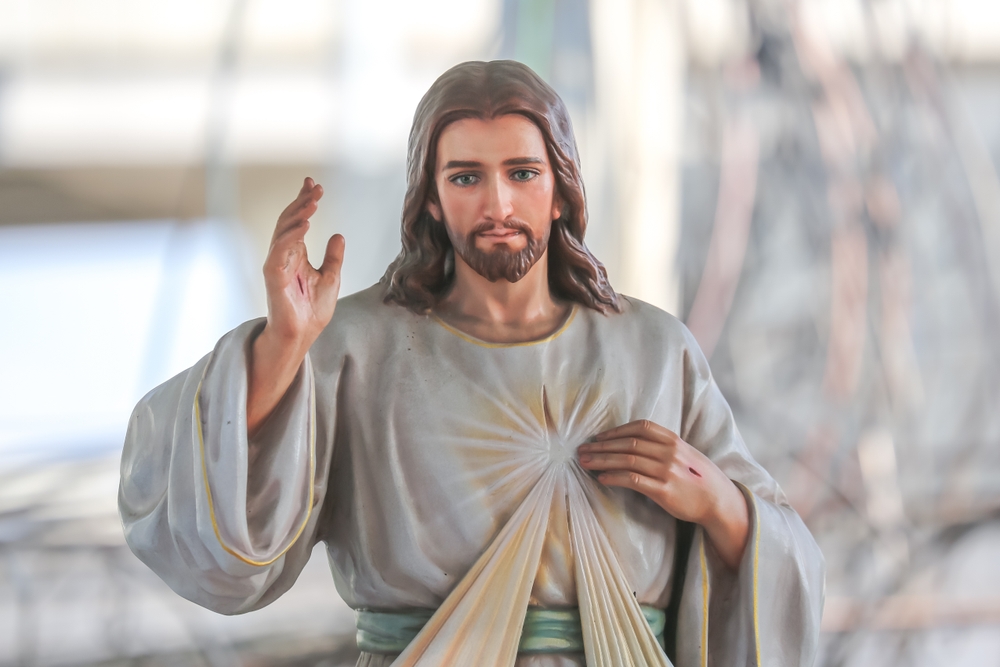AI reveals ‘real’ face of jesus christ based on the shroud of turin

For centuries, the face of Jesus Christ has remained one of the greatest mysteries of both faith and science. Depictions of Jesus have evolved over time—each artist interpreting his features based on culture, tradition, and personal belief. Yet, the question persists: What did Jesus actually look like? Now, thanks to artificial intelligence and a centuries-old relic, we might be closer than ever to answering that question.
The Shroud of Turin, believed by many to be the burial cloth of Jesus, has long captivated both religious and scientific communities. Its faint imprint of a man’s body has been the subject of intense scrutiny, sparking debates about its authenticity and historical significance. But today, AI technology offers us a fresh lens, one that could reveal a more accurate representation of the man behind the legend.
What if, through the power of AI, we could reconstruct the face of a figure whose image has been a central part of history for over two thousand years? Could this technology offer us a glimpse into the past, and if so, what might we learn from seeing the “real” face of Jesus? As AI reconstructs images from ancient artifacts, the face of Jesus emerges not just as a figure of religious importance, but as a symbol of technology’s potential to bridge the gap between faith and the mysteries of the past.

What Is the Shroud of Turin?
The Shroud of Turin, a piece of linen cloth measuring about 14 feet long and 3.5 feet wide, has been a subject of fascination and mystery for centuries. Believed by many to be the burial cloth of Jesus Christ, the Shroud is marked with an image that many say resembles the crucified body of Christ. Its history traces back to at least the 14th century, though some claim it dates back to much earlier, with various theories suggesting it was the cloth used to wrap Jesus’ body after his crucifixion. Despite being housed in Turin, Italy, the Shroud’s journey through history is marked by a trail of controversies, scientific examinations, and religious fervor.
One of the key reasons the Shroud has captivated both religious believers and skeptics alike is the detailed image that appears to be a faint imprint of a man’s face and body. Over the years, numerous scientific studies have attempted to uncover the origins of this imprint, but the answers remain elusive. Carbon dating tests, for example, have placed the Shroud’s creation in the Middle Ages, but these findings have been challenged due to various factors, including the possibility of contamination of the cloth during past repairs. For many, this only deepens the mystery, adding to the Shroud’s allure as a potential link to the historical Jesus.
But it’s not just the image that has captured the imagination of millions; it’s also the mysteries surrounding how the image was created. While some attribute the imprint to a supernatural event, others propose that it could be the result of natural chemical reactions, or even the body’s physical processes following crucifixion. This mixture of faith, history, and science has turned the Shroud of Turin into one of the most debated and intriguing artifacts in human history, keeping people asking the same question: Could this truly be the cloth that once enveloped the body of Jesus Christ?

AI and the Shroud: A Modern Interpretation
Artificial intelligence has opened up new possibilities in a range of fields, but perhaps none as intriguing as its application in historical and religious studies. For the first time, AI has been used to reconstruct an image of Jesus based on the Shroud of Turin, combining modern technology with ancient mysteries. By applying AI to the Shroud’s image, scientists and researchers were able to enhance the existing details, reconstruct the face, and provide a clearer, more defined representation of what Jesus might have looked like—according to this particular artifact.
The process involved using advanced AI techniques like facial recognition and image enhancement, combined with a detailed understanding of human anatomy and ancient textiles. The AI algorithms worked with high-resolution scans of the Shroud to create a composite image, building upon the faint, often distorted outline left by the original imprint. What emerged from this process was a remarkably lifelike image of a man—one that seemed to evoke the same familiar depictions of Jesus in Western art, but with a sense of authenticity that was never before possible.
This new AI-generated image of Jesus doesn’t just provide us with a clearer picture; it also opens the door to important questions about the nature of religious representations. How much of what we know about religious figures is shaped by cultural biases, historical context, and artistic interpretation? And can technology, such as AI, help us get closer to the truth, or does it merely add another layer of complexity to the mystery of faith? The face of Jesus, once an abstract and multifaceted concept, is now brought into sharper focus—thanks to the power of AI. But does this reveal the “real” Jesus, or does it simply offer a modern twist on a centuries-old enigma?

The Face of Jesus: What AI Reveals
The AI-generated image of Jesus, based on the Shroud of Turin, offers us a startling and deeply human representation of the figure that has been at the center of Christianity for two millennia. What sets this image apart from traditional depictions is its rawness and sense of realism. The face, showing a man in his mid-thirties with long hair, a full beard, and a solemn expression, evokes a sense of vulnerability, a far cry from the idealized, often serene portrayals found in religious art. The AI-enhanced image provides a face that many people—whether believers or skeptics—can connect with on a personal level, bringing the figure of Jesus into a more grounded, relatable light.
While the image itself is striking, it’s important to recognize that it’s not a direct representation of Jesus but rather a reconstruction based on the Shroud’s imprint. This subtle distinction matters because it raises the question of authenticity—what does it really mean for a face to be “real”? Is this image a more accurate portrayal of the historical Jesus, or is it just another interpretation that blends science, technology, and faith? The fact that AI was able to produce such a compelling likeness based on centuries-old evidence suggests that there’s something uniquely powerful about the intersection of ancient artifacts and cutting-edge technology.
The AI image challenges the conventional ways we’ve thought about historical and religious figures. For centuries, Jesus’ face has been painted, sculpted, and imagined according to cultural norms and religious ideologies. This new AI-generated face, grounded in the Shroud of Turin, invites us to consider a new kind of representation—one that transcends artistic tradition and aligns more closely with the physical reality suggested by the ancient cloth. It prompts us to think about how images of faith are shaped not only by religious narratives but by the tools and technologies available to us.

How Accurate Is This AI Face?
While the AI-generated image is certainly compelling, the accuracy of this reconstruction is still open to debate. After all, the Shroud itself remains an object of scientific contention. The AI process involved interpreting an image that has long been the subject of mystery and uncertainty, and despite advancements in technology, it’s important to acknowledge the limitations of both the Shroud and the AI tools used to reconstruct it. No matter how advanced AI may be, it cannot fully account for the mysteries that remain within the Shroud’s faint and worn-out imprint.
Experts in various fields have expressed their skepticism about the ability of AI to provide an authentic depiction of Jesus. Historical and theological scholars, for instance, note that any attempt to reconstruct the face of Jesus based on the Shroud will always be an approximation—one that is influenced by modern perceptions of what Jesus might have looked like. The AI-generated image, despite being grounded in the Shroud’s markings, still carries the imprint of our contemporary cultural biases. Moreover, the original image on the Shroud itself is not a perfect representation of a human face but rather a vague, somewhat distorted imprint, leaving plenty of room for interpretation.
The AI model used to reconstruct the face of Jesus certainly relies on impressive technology, but that doesn’t necessarily make the result an objective truth. It’s a fascinating representation based on historical evidence and scientific tools, but it remains an interpretation, one that will be subject to the biases of both the technology and the human researchers involved. As such, the question of how “accurate” this image is should be viewed with a degree of caution and critical thinking. AI may help us bring ancient relics into sharper focus, but it cannot provide us with definitive answers about the past. Instead, it offers us a glimpse into the possibilities of what might have been—while leaving the final interpretation up to us.

The Spiritual Impact of Seeing Jesus’ Face
For many people, seeing a face that could be the most accurate depiction of Jesus Christ is a profound experience. It transcends the physical and enters the spiritual realm, where the face becomes more than just a historical figure—it becomes a symbol of divine mystery and human connection. The AI-generated image of Jesus offers something different from the idealized, distant figures found in traditional religious art; it offers a face that seems more accessible, more human, and, in some ways, more relatable.
This new image of Jesus could have a significant impact on how people connect with their faith. For some, seeing Jesus’ face in such a raw, realistic form might deepen their spiritual connection, reminding them that the historical Jesus was a man like any other, with real human experiences. It’s a face that reflects both suffering and compassion—an image that could speak to the hearts of millions. For others, it might spark a sense of awe or reverence, prompting deeper reflection on the nature of faith and the power of technology to reveal ancient truths.
However, the impact of seeing such an image is not just about the individual’s relationship with Jesus; it also touches on broader questions of how we approach religious iconography. What does it mean to “see” Jesus in the digital age? How does this AI-generated face change our understanding of divine representation? The image challenges traditional ideas and opens up new avenues for spiritual exploration. It asks us to consider the ways in which technology, faith, and human experience intersect, pushing us to redefine what it means to encounter the divine.
A New Chapter in Faith and Technology
The AI-generated image of Jesus Christ, based on the Shroud of Turin, represents more than just a technological achievement—it’s a moment in history where faith and science meet in unexpected ways. While the image itself may never be definitively proven to be the “real” face of Jesus, it offers a compelling glimpse into what might have been. The intersection of AI and ancient artifacts allows us to ask new questions, explore old mysteries, and perhaps, in some way, deepen our connection to both the past and our spiritual beliefs.
At the same time, it’s important to remember that technology is a tool, not a replacement for faith. The face of Jesus is not just an image—it’s a symbol that transcends time and culture, carrying with it profound spiritual significance. Whether or not the AI-generated face accurately reflects the historical Jesus, it reminds us that our understanding of the past is always evolving, and that technology can play a role in helping us better understand our beliefs.
As we move forward, we must remain open to the possibilities that technology offers, while also honoring the sacred nature of faith. The AI face of Jesus is just one example of how science and spirituality can work together to uncover truths—truths that have the power to inspire, challenge, and transform. The journey to understand the face of Jesus, and the deeper mysteries of faith, continues, and with each new discovery, we move closer to a fuller understanding of who He was, and what He represents in the world today.
Loading...

